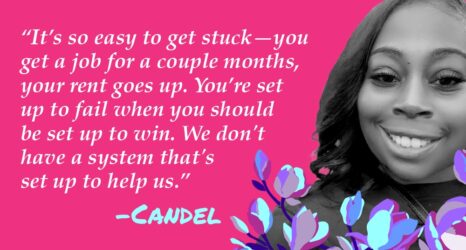The holidays can bring families together. But amidst the childcare crisis, they also remind parents how little time they share the rest of the year.

With the holidays upon us, many are eagerly planning special gatherings with family. But for some parents with young kids, it might be the only time they spend together all year.
Welcome to the era of split-shift parenting.
In a country where roughly two out of every five parents struggle to afford care for their kids, many couples have resorted to parenting in shifts: One parent looks after the kid(s) while the other works, and then they swap.
While tag-team parenting can certainly help couples tighten their purse strings, it often comes at a price.
It’s hard to know exactly how many couples today are split-shift parenting. But as recently as 2018, 12 percent of moms worked shifts other than a 9-to-5—and 40 percent did it because of caregiving responsibilities. That’s millions of moms.
And since about 3 million kids face losing access to their childcare after pandemic-era funding expired in September, the problem isn’t just affording care—it’s finding an open spot. One mother in Washington heard about three-year waitlists for some preschool programs—meaning she would have had to sign up before she became pregnant.
When the whole family is stretched thin, we know exactly who picks up the slack: moms.
Divvying up childcare isn’t a new concept. Back in the ’90s, some couples praised the perks of splitting shifts—not only because it kept costs down, but because it helped make care work more equitable. In 1992, dad Romulo Cerda said it helped him see himself as a more equal parent, “even if it means changing diapers.” Diapers—the horror!
It all sounds like a winning formula for childcare: Keep the costs down, and the workload fair, while getting the kids fed, bathed, and put to bed on time. But as the CEO of Moms First, I spend a lot of time talking about how hard it is to balance the childcare equation—and I wanted to hear from the moms actually doing it. So I asked my social media followers: What is split-shift parenting like in 2023?
And one word popped up over and over again: exhausting.
X user Niki Alexander (@tncalexander) said she only slept when she got her son down for a nap—hearkening back to a parent who told NPR they started work at 4 a.m. so their partner could take clients in the afternoon.
One mom on Instagram, Erika Frantz (@eefrantz) said she “finally ‘cracked’ from lack of sleep.” She was able to switch her hours, but “that still left us with no days together to spend as a family.”
As Lily Schott (@lillyschott), a nurse, summed it up: It’s “really just a symptom of how broken the system is that it’s a luxury and a rare event that the whole family can be together.”
Many, too, worry about the toll splitting shifts took on their kids. As Mamta Jain Valderrama (@mamatavalderrama) commented: “The worst is that my daughter (still young) is constantly telling me all the things I’m not doing, like being with her while she eats because I need to take a shower.”
And when the whole family is stretched thin, we know exactly who picks up the slack: moms.
That’s true even in supposedly egalitarian households. One recent study showed that when a wife’s salary matches or exceeds her husband’s, she still spends more time on caregiving. The only time a wife spends fewer hours than her husband on childcare is when she is the sole breadwinner.
Too often, moms have no other option than to anxiously wait for their partner to get home from work, so they can pass the baton—or perhaps literally pass the baby—and report for duty themselves.
None of this is to say that split-shift parenting is inherently bad. On the contrary, for some, it’s empowering. But when childcare costs are outpacing college tuition and paid family leave isn’t guaranteed, tag-team parenting is rarely much of a choice at all.
If our nation’s policies were actually designed with families’ needs in mind, would some still choose the split-shift model? Maybe. But there are many—and I’d argue, many more—who wouldn’t.
Too often, moms have no other option than to anxiously wait for their partner to get home from work, so they can pass the baton—or perhaps literally pass the baby—and report for duty themselves. And that’s to say nothing about single parents, nearly a quarter of households with kids, who don’t have another parent at home to split shifts with.
Moms deserve more options. Better options. Sustainable options—and they need them urgently.
Right now, moms in the workforce are at a turning point. After the pandemic forced nearly 2 million women from their careers, they’ve returned in full force: Today, more women with young kids are working than ever before. And—though the gender pay gap is still very, very real—the percentage of women with wages that match or exceed their husbands’ has roughly tripled in the past 50 years.
But as we saw during COVID, that progress hangs by a thread. If our legislators, our business leaders, our bosses are as committed to gender equity as they claim to be, they need to support moms.
That means increasing access to affordable childcare, guaranteeing paid leave, instituting flexible work policies—and refusing to let those priorities fall by the wayside ever again. Because if we do make these investments, there’s reason to believe they’ll pay for themselves.
So here’s my holiday gift to the moms who were raised on the gospel of “having it all,” only to feel like a failure when they can’t: This isn’t your fault. The system is broken. And split-shift parenting is proof.
This choice—between spending your entire savings, or otherwise sacrificing your sleep, freedom and family time—is a false one.
The sooner we acknowledge it, the sooner we can move beyond it.
Up next:
U.S. democracy is at a dangerous inflection point—from the demise of abortion rights, to a lack of pay equity and parental leave, to skyrocketing maternal mortality, and attacks on trans health. Left unchecked, these crises will lead to wider gaps in political participation and representation. For 50 years, Ms. has been forging feminist journalism—reporting, rebelling and truth-telling from the front-lines, championing the Equal Rights Amendment, and centering the stories of those most impacted. With all that’s at stake for equality, we are redoubling our commitment for the next 50 years. In turn, we need your help, Support Ms. today with a donation—any amount that is meaningful to you. For as little as $5 each month, you’ll receive the print magazine along with our e-newsletters, action alerts, and invitations to Ms. Studios events and podcasts. We are grateful for your loyalty and ferocity.





